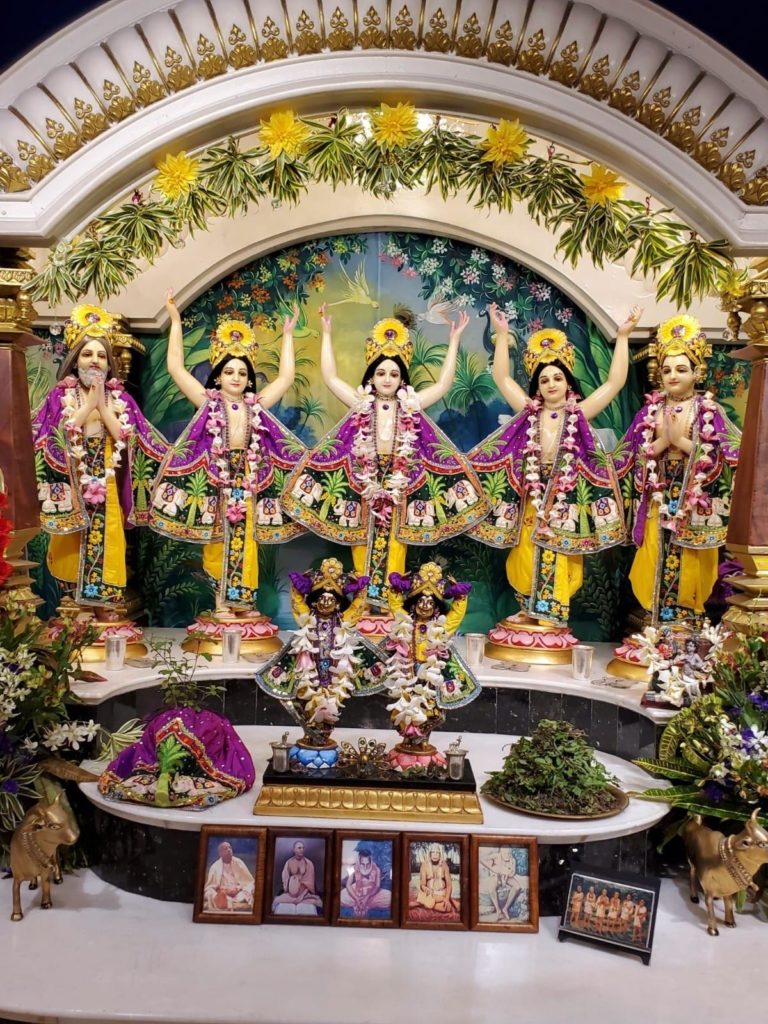“Śrīla Prabhupāda’s Kīrtana Standards,” installment 21

Chant the Pañca-tattva mantra first
In a Caitanya-caritāmṛta purport, Śrīla Prabhupāda instructed:
At the beginning of every function in preaching, especially before chanting the Hare Kṛṣṇa mahā-mantra—Hare Kṛṣṇa, Hare Kṛṣṇa, Kṛṣṇa Kṛṣṇa, Hare Hare / Hare Rāma, Hare Rāma, Rāma Rāma, Hare Hare—we must chant the Pañca-tattva’s names and offer our respects to them.1
In the previous chapter he had written:
As preachers of the Kṛṣṇa consciousness movement, we first offer our obeisances to Śrī Caitanya Mahāprabhu by chanting this Pañca-tattva mantra; then we say Hare Kṛṣṇa, Hare Kṛṣṇa, Kṛṣṇa Kṛṣṇa, Hare Hare / Hare Rāma, Hare Rāma, Rāma Rāma, Hare Hare. There are ten offenses in the chanting of the Hare Kṛṣṇa mahā-mantra, but these are not considered in the chanting of the Pañca-tattva mantra, namely, śrī-kṛṣṇa-caitanya prabhu-nityānanda śrī-advaita gadādhara śrīvāsādi-gaura-bhakta-vṛnda. Śrī Caitanya Mahāprabhu is known as mahā-vadānyāvatāra, the most magnanimous incarnation, for He does not consider the offenses of the fallen souls. Thus to derive the full benefit of the chanting of the mahā-mantra (Hare Kṛṣṇa, Hare Kṛṣṇa, Kṛṣṇa Kṛṣṇa, Hare Hare / Hare Rāma, Hare Rāma, Rāma Rāma, Hare Hare), we must first take shelter of Śrī Caitanya Mahāprabhu, learn the Pañca-tattva mahā-mantra, and then chant the Hare Kṛṣṇa mahā-mantra. That will be very effective.2
But not again and again and again
Although Śrīla Prabhupāda wanted us to begin kīrtana by chanting the Pañca-tattva mantra, he didn’t want us to chant it many, many times. Harikeśa writes:
My personal experience with Prabhupada began when I was his servant for a while in July of 1971. At that time he had described to me in his room that the chanting of the Pancatattva maha mantra was much more powerful that the hare krsna mantra. I immediately asked him that since this is so, then why don’t we chant some rounds of this mantra after finishing our 16 rounds of the hare krsna mantra each day? Prabhupada replied that we should not do so since Lord Caitanya came just to show us how to worship Lord Krsna and that the Lord wanted us to chant the hare krsna mantra and therefore we should follow His advice and example. Therefore he later restricted the chanting of this mantra in kirtan to only three times.
Specifically he placed this restriction on the chanting after one incident with Isan prabhu in Vrindavan. In July of 1974, when he first moved into his new quarters, we were both holding kirtans in his room in the afternoon and then Prabhupada would give class. On one of the first days, Isan prabhu, who at that time was doing what was to be later known as FATE doll exhibition, led a kirtan. He was simply repeating the sri krsna mantra [sri krsna caitanya. . .] over and over again, perhaps for 15 times, when Prabhupada demanded that he stop and chant hare krsna. It was after this that Prabhupada became quite strict on the number of times the mantra was sung.3
Jaya, not bhaja
Devotees who listen to Śrīla Prabhupāda’s kīrtanas will hear him precede the Pañca-tattva mantra with “bhaja.” Yet the standard in ISKCON is not “bhaja” but “jaya.” Harikeśa explains that in June of 1977 Śrīla Prabhupāda himself instituted the change from “bhaja” to “jaya” to distinguish us from “the chanters across the road” in Vrindāvan who sing the concocted mantra “(bhaja) nitai gaura rādhe śyām (japa) hare kṛṣṇa hare rām.”4
On another occasion Śrīla Prabhupāda said:
You can say “Śrī Kṛṣṇa Caitanya” or “Jaya Śrī Kṛṣṇa Caitanya,” but never “bhaja.” You just glorify these five personalities and They will take care of everything.5
Notes:
1 Cc. Ādi 8.4, purport.
2 Cc. Adi 7.4, purport.
3 Harikeśa Swami, “Important Kirtan Instructions from Srila Prabhupada.”
4 Harikeśa Swami, “Important Kirtan Instructions from Srila Prabhupada.” There Harikeśa gives a fuller account of how Śrīla Prabhupāda instituted this change.
5 TKG’s Diary, entry for May 29, 1977.

You must be logged in to post a comment.